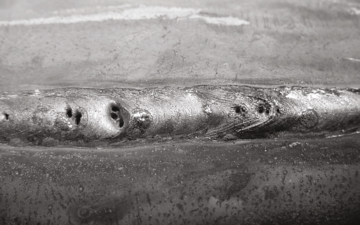Discover What is Porosity in Welding and Its Result on Structural Honesty
Discover What is Porosity in Welding and Its Result on Structural Honesty
Blog Article
The Scientific Research Behind Porosity: A Comprehensive Overview for Welders and Fabricators
Understanding the elaborate systems behind porosity in welding is crucial for welders and fabricators pursuing flawless workmanship. As metalworkers explore the midsts of this sensation, they reveal a globe governed by various variables that affect the formation of these tiny spaces within welds. From the make-up of the base materials to the ins and outs of the welding process itself, a wide variety of variables conspire to either intensify or ease the existence of porosity. In this extensive guide, we will unravel the science behind porosity, discovering its results on weld top quality and introduction progressed strategies for its control. Join us on this journey via the microcosm of welding blemishes, where accuracy fulfills understanding in the quest of flawless welds.
Recognizing Porosity in Welding
FIRST SENTENCE:
Assessment of porosity in welding discloses essential understandings into the honesty and high quality of the weld joint. Porosity, defined by the visibility of cavities or gaps within the weld metal, is a common worry in welding processes. These voids, otherwise correctly attended to, can jeopardize the architectural honesty and mechanical buildings of the weld, causing potential failures in the completed product.

To find and evaluate porosity, non-destructive screening approaches such as ultrasonic testing or X-ray examination are typically employed. These techniques permit the recognition of internal issues without endangering the stability of the weld. By evaluating the size, form, and circulation of porosity within a weld, welders can make informed choices to boost their welding processes and achieve sounder weld joints.

Factors Influencing Porosity Development
The incident of porosity in welding is influenced by a myriad of aspects, varying from gas securing effectiveness to the intricacies of welding parameter settings. Welding specifications, consisting of voltage, existing, travel rate, and electrode kind, likewise impact porosity formation. The welding method used, such as gas steel arc welding (GMAW) or protected metal arc welding (SMAW), can influence porosity development due to variants in warmth circulation and gas insurance coverage - What is Porosity.
Effects of Porosity on Weld Top Quality
Porosity development dramatically jeopardizes the architectural integrity and mechanical residential properties of welded joints. When porosity is present in a weld, it creates gaps or cavities within the product, lowering the overall stamina of the joint. These gaps serve as stress and anxiety concentration factors, making the weld much more at risk to breaking and failing under lots. The existence of porosity also compromises the weld's resistance to deterioration, as the trapped air or gases within the spaces can respond with the surrounding setting, bring about degradation in time. Additionally, porosity can prevent the visit this site weld's capability to endure pressure or effect, further threatening the total quality and reliability of the bonded framework. In vital applications such as aerospace, automotive, or architectural buildings, where safety and durability are paramount, the damaging impacts of porosity on weld high quality can have severe effects, emphasizing the value of lessening porosity via correct welding strategies and treatments.
Methods to Reduce Porosity
Furthermore, utilizing the proper welding specifications, such as the correct voltage, present, and travel speed, is vital in preventing porosity. Preserving a regular arc size and angle throughout welding likewise assists lower the chance of porosity.

Furthermore, choosing the right securing gas and keeping correct gas circulation prices are important in reducing porosity. Using the suitable welding strategy, such as back-stepping or employing a weaving activity, can also help disperse warm equally and reduce the chances of porosity formation. Making sure proper ventilation in the welding atmosphere to remove any kind of possible resources of contamination is vital for accomplishing porosity-free welds. By Learn More applying these techniques, welders can successfully reduce porosity and create top quality bonded joints.

Advanced Solutions for Porosity Control
Carrying out advanced technologies and cutting-edge techniques plays a crucial duty in accomplishing exceptional control over porosity in welding processes. One sophisticated service is the usage of sophisticated gas blends. Shielding gases like helium or a mix of argon and hydrogen can help in reducing porosity by supplying much better arc security and improved gas insurance coverage. Additionally, utilizing innovative welding methods such as pulsed MIG welding or modified environment welding can likewise assist reduce porosity concerns.
One more sophisticated remedy involves making use of advanced welding tools. As an example, using devices with built-in attributes like waveform control and sophisticated source of power can boost weld quality and lower porosity threats. The execution of automated welding systems with specific control over specifications can dramatically decrease porosity flaws.
Furthermore, incorporating innovative monitoring and evaluation technologies such as real-time X-ray imaging or automated ultrasonic screening can assist in finding porosity early in the welding procedure, permitting immediate restorative actions. Generally, integrating his comment is here these sophisticated options can considerably enhance porosity control and boost the overall high quality of bonded elements.
Final Thought
In final thought, comprehending the scientific research behind porosity in welding is crucial for welders and makers to create premium welds - What is Porosity. Advanced options for porosity control can better improve the welding process and guarantee a solid and reliable weld.
Report this page